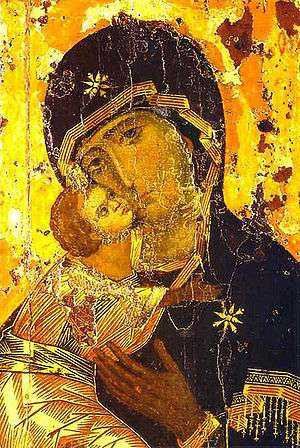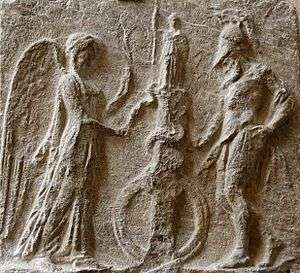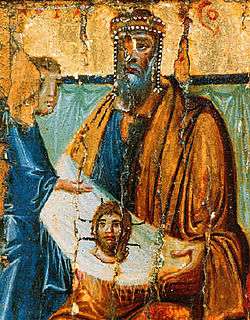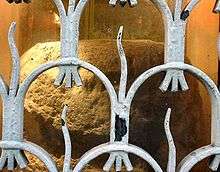Palladium (protective image)

A palladium or palladion is an image or other object of great antiquity on which the safety of a city or nation is said to depend. The word is a generalization from the name of the original Trojan Palladium, a wooden statue (xoanon) of Pallas Athena that Odysseus and Diomedes stole from the citadel of Troy and which was supposedly later taken to the future site of Rome by Aeneas, where it remained until perhaps transferred to Constantinople and lost sight of after the conversion of the Empire to Christianity.
In English, since around 1600, the word "palladium" has been used figuratively to mean anything believed to provide protection or safety,[1] and in particular in Christian contexts a sacred relic or icon believed to have a protective role in military contexts for a whole city, people or nation. Such beliefs first become prominent in the Eastern church in the period after the reign of the Byzantine Emperor Justinian I, and later spread to the Western church. Palladia were processed around the walls of besieged cities and sometimes carried into battle.[2] In this more offensive role they may also be referred to as "vexilla" (singular vexillum, Latin for "battle standard").
Classical antiquity

Troy and Rome
The original Palladion was part of the foundation myths of both Troy and Rome. It was a wooden image of Pallas (whom the Greeks identified with Athena and the Romans with Minerva) said to have fallen from heaven in answer to the prayer of Ilus, the founder of Troy. In the Trojan War the besieging Greeks discovered that they would be unable to take the city while it was protected by it, and so Odysseus and Diomedes stole from the citadel of Troy before taking the city by the ruse of the Trojan Horse. According to a later set of myths it was then taken to Rome, where an actual image, unlikely to have been actually of Trojan origin, was kept in the Temple of Vesta in the Roman Forum for centuries, and regarded as one of the pignora imperii, sacred tokens or pledges of Roman rule (imperium). The Roman story is related in Virgil's Aeneid and other works.
Athens
The goddess Athena was worshipped on the Acropolis of Athens under many names and cults, the most illustrious of which was of the Athena Poliás, "[protectress] of the city". The cult image of the Poliás was a wooden effigy, often referred to as the "xóanon diipetés" (the "carving that fell from heaven"), made of olive wood and housed in the east-facing wing of the Erechtheum temple in the classical era. Considered not a man-made artefact but of divine provenance, it was the holiest image of the goddess and was accorded the highest respect. It was placed under a bronze likeness of a palm tree and a gold lamp burned in front of it. The centerpiece of the grand feast of the Panathenaea was the replacement of this statue's woolen veil with a newly woven one. It was also carried to the sea by the priestesses and ceremonially washed once a year, in the feast called the Plynteria ("washings"). Its presence was last mentioned by the Church Father Tertullian (Apologeticus 16.6), who, in the late 2nd century AD, described it derisively as being nothing but "a rough stake, a shapeless piece of wood" (Latin original: "[] Pallas Attica [] quae sine effigie rudi palo et informi ligno prostat?"). Earlier descriptions of the statue have not survived.
Christian palladia

Around the end of the 6th century the first references to Christian palladia start to appear.[3] The Image of Edessa in Armenian Mesopotamia, or Mandylion, later moved to Constantinople, is one of the first and long the most famous examples. This was later credited with the failure of the Persian siege of Edessa in 544. But the image is not mentioned in the account of Procopius, writing soon after the event, and first appears as the agent of the failure in the history of Evagrius Scholasticus of about 593.[4] Specific icons, especially those of the Virgin Mary or Virgin and Child became credited with specialist functions, with their veneration aiding against disease or other misfortunes, and the military role of palladium was an example of this.
Beliefs attributing particular icons as palladia were found especially in the Eastern church, and have remained particularly powerful in Russian Orthodoxy, where a number of icons protected different cities. In Celtic Christianity palladia were more often relics, which in the Celtic tradition were typically possessions of a saint, such as books, bells, belts and croziers, all housed in reliquaries, and in Irish circumstances functioned as the battle standards of clans rather than protecting a city. They were sometimes carried into battle in their reliquaries or cumdach, hanging by a chain around the neck of a member of the clan. In the Western church such beliefs have declined even in Catholic countries since the Reformation, and disappeared in Protestant beliefs. Various folk myths have instead arisen, but these are probably not regarded very seriously even by the general public.
The Byzantine palladia, which first appear in the late 6th century, cannot be said to have had a very successful track record, as apart from Constantinople most major cities in Egypt, Syria and later Anatolia fell to Muslim attacks.[5] Just before the start of the Byzantine Iconoclasm an incident of what might be called a "reverse-palladium" is recorded. According to Iconoclast sources an officer called Constantine, defending Nicaea against an Arab siege in 727, smashed an icon of the Virgin, and this saved the city. The Iconodule sources also record the incident, but say that Constantine was promptly killed, and the city saved by other icons, including the famous series of 318 portraits of participants in the First Council of Nicaea which adorned the hall where the council had met in 325.[6]
- The Image of Camuliana was an icon of Christ which was the earliest important palladium of Constantinople after it reached the city in 574, but seems to have been destroyed in the Byzantine Iconoclasm.[7]
- The Virgin Hodegetria — an ancient Madonna and Child image — was the traditional protectress of Byzantine Constantinople. At times of siege it was paraded along the city walls.[8] At the final fall of the city (1453) it failed to deter the Turks, was pillaged, and disappeared forever.
- The Cathach of St. Columba, a 6th-century Irish psalter, processed round the troops and carried into battle ("Cathach" means "battler") by the O'Donnell Clan,[9] carried round the neck in its cumdach.
- Theotokos of Vladimir, a Byzantine icon of the Virgin considered the protectress of Moscow in particular, and Russia in general, now in the Tretyakov Gallery in Moscow. It was in particular credited with saving Moscow from the attack of Tamerlane in 1395, and the Tatar armies in 1451 and 1480.
- Our Lady of the Sign, protector of Novgorod, and especially credited with saving the city in the Battle of the Novgorodians with the Suzdalians in 1169, which was probably soon after it was painted.
- The Girdle of Thomas or Sacra Cintola, supposed the belt of the Virgin Mary, paraded round the city of Prato near Florence in 1402 when a Milanese army threatened, and perhaps on other occasions.
- Our Lady of Kazan, a holy icon, considered the protectress of Russia and lost in 1904, though copies were used to bolster the morale of troops in both World Wars.
In other cultures

- The Emerald Buddha, a palladium (Thai: ขวัญเมือง kwan mueang; colloquially มิ่งเมีอง ming mueang) of the Kingdom of Thailand. Every Thai city and town has a kwan mueang or ming mueang (usually, but not necessarily, an image of Buddha).
- In Sri Lanka the Relic of the tooth of the Buddha is often described as a palladium in the rather different sense that control of it represented the legitimacy of the king.
- In the Khmer Empire, specific lingams associated with monarchs appear to have had a palladium-like role in the devaraja royal cult, although the subject remains controversial among scholars.[10]
- Among many other figurative uses, in the United States, the Constitution (especially its Second and Seventh Amendments) has sometimes been referred to as the "Palladium of Liberty" or the "Palladium of the Republic" as guarantor of civil liberties. Thorstein Veblen famously referred to business enterprise as the "Palladium of the Republic". The Christian Palladium was a significant evangelical journal in the United States, appearing between 1832 and 1862, and connected to the Christian Connection and Restoration Movements.[11]
- Palladia in modern folk myth include the Ravens of the Tower of London, probably 19th century in origin, though dubious 17th-century origins have been claimed. These are somewhat typical of folk myth in being one-sided in their effect, in that their removal is said to presage disaster, but their continued presence is not usually held to have significant benefit. The isolated population of Barbary macaques in Gibraltar, whose continued presence is said to ensure British control, are a similar case.
- The Luck of Edenhall is an exceptionally fine and pristine example of 14th century luxury Islamic glass, made in Syria or Egypt, and now in the Victoria and Albert Museum in London. It was in the possession of the Musgrave family of Edenhall, Cumberland, from an unknown but early date, and is recorded in 1791 as having "by tradition" a reputation as a palladium for its owners:[12]
- "If this cup should break or fall
- Farewell the Luck of Edenhall!"
- The cup has a custom-made 15th-century European leather case and the name is first recorded in a Musgrave will of 1677. A number of other Northern gentry families had a variety of objects called "Lucks", and "Luck of Troy" was an old English term for the Trojan and Roman prototype;[13][14] the first recorded use of "luck" in this sense is a reference to the Luck of Edenhall.[15]

- Some writers have suggested that the historic London Stone was once regarded as London's palladium.[16] Notably, a pseudonymous contributor to the journal Notes and Queries in 1862 quoted a supposedly ancient proverb to the effect that "So long as the Stone of Brutus is safe, so long shall London flourish".[17] This verse, if it were genuine, would link the Stone to Brutus of Troy, legendary founder of London, as well as confirming its role as a palladium. However, the writer can be identified as the Richard Williams Morgan, an eccentric Welsh clergyman who in an earlier book had claimed that the legendary Brutus was a historical figure; London Stone, he wrote, had been the plinth on which the original Trojan Palladium had stood, and was brought to Britain by Brutus and set up as the altar stone of the Temple of Diana in his new capital city of Trinovantum or "New Troy" (London).[18]
- This story, and the verse about the "Stone of Brutus", can be found nowhere any earlier than in Morgan's writings. No one before Morgan had called London Stone "The Stone of Brutus", and although the spurious verse is still frequently quoted, there is no evidence that London's safety has ever traditionally been linked to that of London Stone.[19]
See also
Notes
- ↑ OED, "Palladium, 2", first recorded use 1600
- ↑ Kitzinger, 109-112
- ↑ Kitzinger, 103-110
- ↑ Kitzinger, 103-104
- ↑ Mango, 3
- ↑ Mango, 2-3
- ↑ Beckwith, 88
- ↑ Beckwith, 88-89
- ↑ The Cathach at the Royal Irish Academy
- ↑ Crosby, Kate, "Devaraja", p. 418, in Southeast Asia: A Historical Encyclopedia, from Angkor Wat to Timor, Volume 3, R-Z, ed. Ooi Keat Gin, 2004, ABC-CLIO, ISBN 1576077705, 9781576077702, google books
- ↑ Foster, Douglas A., The Encyclopedia of the Stone-Campbell Movement: Christian Church (Disciples of Christ), Christian Churches/Churches of Christ, Churches of Christ, 2004, Wm. B. Eerdmans Publishing, ISBN 0802838987, 9780802838988
- ↑ quote, and verses, article by Rev. William Mounsey of Bottesford in The Gentleman's Magazine, 1791
- ↑ "The Luck of Edenhall in the Victoria and Albert Museum". Victoria and Albert Museum. 2012-05-08. Retrieved 2012-05-08.;"The Luck of Edenhall (Eden Hall)". Pitt.edu. 2010-07-14. Retrieved 2011-02-09.
- ↑ Beard, 84-97 describes the "Luck of Muncaster" and other examples, mostly cups; his next chapter is on the Luck of Edenhall.
- ↑ OED, "Luck"
- ↑ Clark, John. "London Stone" (PDF). Vintry and Dowgate Wards Club. Retrieved 24 April 2013.
- ↑ Mor Merrion (1862). "Stonehenge". Notes and Queries. 3rd series. 1: 3.
- ↑ Morgan, Richard Williams (1857). The British Kymry or Britons of Cambria. Ruthin: Isaac Clarke. pp. 26–32.
- ↑ Clark 2010, pp. 45–52.
References
- Beard, Charles R., Luck And Talismans: A Chapter of Popular Superstition, 2004 reprint, Kessinger Publishing, ISBN 1417976489, 9781417976485, google books
- Beckwith, John, Early Christian and Byzantine Art, Penguin History of Art (now Yale), 2nd edn. 1979, ISBN 0140560335
- Kitzinger, Ernst, "The Cult of Images in the Age before Iconoclasm", Dumbarton Oaks Papers, Vol. 8, (1954), pp. 83–150, Dumbarton Oaks, Trustees for Harvard University, JSTOR
- Mango, Cyril, "Historical Introduction," in Bryer & Herrin, eds., Iconoclasm, pp. 2–3., 1977, Centre for Byzantine Studies, University of Birmingham, ISBN 0704402262
Other sources
- The Oxford Dictionary of Classical Myth and Religion. s.v. "Palladium".
External links
| Wikimedia Commons has media related to Palladium (mythology). |

